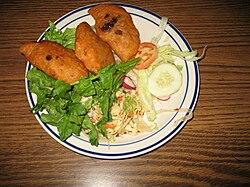Pasteles

Pasteles de picadillo
|
|
| Type | Dumpling |
|---|---|
| |
|
Pasteles (Spanish pronunciation: [pasˈteles]; singular pastel) are a traditional dish in several Latin American countries. In Puerto Rico, the Dominican Republic, Trinidad and Tobago, the Caribbean coast of Colombia, and Panama, it is similar to a tamale. In Central American cuisine, it more closely resembles a British pasty or an Italian calzone. In other Spanish-speaking countries, pastele is a generic term for pastry. In Hawaii, they are called pateles in a phonetic rendering of the Puerto Rican pronunciation of Pasteles, as discussed below.
Colombian pasteles are called pastel de arroz cartagenero (rice pasteles) and are more of a tamale than a typical pastel. Is made up of rice that is seasoned and left out in the sun; a process referred to as orear (to air). The rice is then mixed with many ingredients. Pickled vegetables, chorizo, pork, chickpeas, olives, and potatoes are the most common. Chicken and beef are also used. Colombian pasteles are wrapped twice, once with a cabbage leaf, and again with a banana leaf. This is the typical meal of the Nochebuena Dinner (Christmas Eve), in the Caribbean Coast Region of Colombia since their humble beginnings. It's often confused with the tamal from the andean region which is made up with corn.
Known as Pasteles en hojas, Dominicans usually use three tubers plantains, malanga and squash are most popular. The tubers are grated into what is called masa. Masa is then placed on a banana leaf. The masa is then filled with meat. Different meats and seasoning from around the island can be used; ground pork seasoned with sofrito and ground annatto is the most common and traditional.
...
Wikipedia
